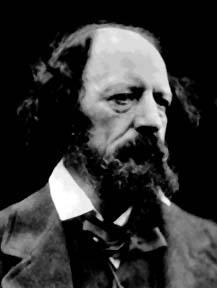Alfred, Lord Tennyson was the most popular English poet of the Victorian era. He was born in Lincolnshire in 1809, the son of a rector. Due to lack of funds after his father died, he was unable to complete his degree at Cambridge but instead published his collected poems in two volumes (1830 and 1832) but the reviews attacked them as affected and obscure. Tennyson continued writing. despite the death of a good friend, Athur Hallam, and three of his brothers suffering mental illness. The family moved to London and Alfred made friends with various prominent men. In Memoriam (1850), his elegiac poem in honour of his friend was immensely successful with reviewers, the public and Queen Victoria and he was appointed Poet Laureate. He married and the remainder of his life was secure. With his poetic success, he was able to purchase several country homes to avoid his public fame. In 1884, he received a peerage and died in 1892.
Early poems from his first volumes include “The Lady of Shalott” based on a romantic Arthurian legend, “The Lotus Eaters” and “Ulysses” inspired by Homer’s ancient Greek work the Odyssey. In Memoriam is a long poem that questions meaning of life and death, in dealing with the loss of his friend and traces  many Victorian intellectual concerns particularly the reconciliation of traditional religion and the belief in immortality with new theories of evolution and modern geology. The poems describe the poet’s gradual acceptance and understanding of the death and conclude with a marriage song for his sister. His collection Maud and Other Poems (1855) included the “monodrama” (speaker telling story in sequence of short lyrics of various meters) of the title. Another of the poems was the famous “Charge of the Light Brigade” about a costly and tragic military blunder in Russia and feature the lines “Theirs not to reason why,/Theirs but to do and die.” Idylls of the King (1859) was based on the legend of King Arthur and focused on the evil introduced by the adulterous liaison between Queen Guinevere and Lancelot and the gradual fading of hope from the Round Table. This was a huge success. He published further Arthurian works in The Holy Grail, and Other Poems (1869) to continued acclaim, though some questioned the infusion of Victorian moral issues into the original material by Sir Thomas Malory.
many Victorian intellectual concerns particularly the reconciliation of traditional religion and the belief in immortality with new theories of evolution and modern geology. The poems describe the poet’s gradual acceptance and understanding of the death and conclude with a marriage song for his sister. His collection Maud and Other Poems (1855) included the “monodrama” (speaker telling story in sequence of short lyrics of various meters) of the title. Another of the poems was the famous “Charge of the Light Brigade” about a costly and tragic military blunder in Russia and feature the lines “Theirs not to reason why,/Theirs but to do and die.” Idylls of the King (1859) was based on the legend of King Arthur and focused on the evil introduced by the adulterous liaison between Queen Guinevere and Lancelot and the gradual fading of hope from the Round Table. This was a huge success. He published further Arthurian works in The Holy Grail, and Other Poems (1869) to continued acclaim, though some questioned the infusion of Victorian moral issues into the original material by Sir Thomas Malory.
Tennyson was an artist who consolidated and redefined the traditions of the Romantic movement - especially Wordsworth, Byron, and Keats – by skilfully using a variety of metres, melodic harmonies and plush imagery. His moral, religious, political and aesthetic position reflected the views of the educated middle-class English. He confronted particular issues about Christianity and humans place in the universe with regard to scientific and technological progress.